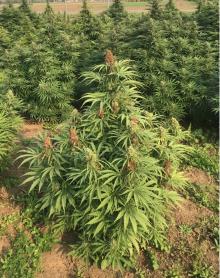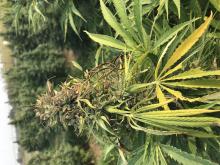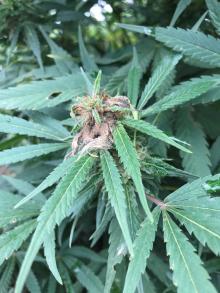By C. M. Ocamb and N. K. Osterbauer
Cause The fungus, Botrytis cinerea (teleomorph: Botryotinia fuckeliana), is an opportunistic pathogen that easily invades weak, damaged, or senescing tissue. This fungus is very common in the Pacific Northwest and occurs worldwide in greenhouses. Cannabis can be killed within one week. Spores (conidia) are produced throughout the growing season under a wide range of temperatures and humidity; and stem infections are a durable inoculum source, producing conidia throughout bloom. Cool temperatures between 50-80°F (68°F is optimal), high humidity, and free water on plant surfaces favor infection and development of symptoms. Rainy periods during bud maturation can bring on large disease outbreaks in hemp. Durable sclerotia overwinter in soil.
Symptoms The pathogen causes brown, water-soaked spots on buds or chlorotic areas on stems. Buds eventually die, bud tissues turn brown and may produce a gray-brown mass of spores. Botrytis cankers develop to the point of limb breakage or stem splitting, especially if plant canopies are dense and heavy. Small, black sclerotia can develop within stem tissues. Like the buds, cankers produce gray-brown masses of spores. Seedlings can also be killed.
Cultural control
- To minimize conductive conditions for gray mold, increase plant spacing, row spacing, and row orientation to promote air movement within and around plants.
- Avoid practices that keep plants wet for 12 hours or longer. Limit irrigation during and after bloom. Use bottom-watering methods rather than overhead irrigation. Irrigate in the morning so that plants' foliage can dry before sundown. Do not over-water in the greenhouse, and prevent standing water or pooled water inside greenhouses.
- In greenhouses, maintain the relative humidity below 50%, temperatures warm, and high light intensity. Filtering out UV light may prevent epidemics since sporulation requires UV light.
- Avoid mechanical injuries to plants since Botrytis can infect easily through wounds.
- Avoid over-fertilization with nitrogen.
- Canopy management is the best preventive method.
Chemical control
- Regalia (Group P5) at 1 to 4 quarts/A on 7- to 10-day intervals. Does not benefit from the addition of an adjuvant. Preharvest interval is 0 days. 4-hr reentry. O
- Vacres (potassium bicarbonate) at 2.5 to 5 lb/A on 7- to 14-day intervals. Preharvest interval is zero (0) days. 4-hr reentry.
Biological control
- LifeGard WG at 1 to 4.5 oz/A on 3- to 14-day intervals for activating plant resistance. Refer to label for appropriate rate per application volume. Preharvest interval is 0 days. 4-hr reentry. O
- Stargus at 0.5 to 4 quarts/A on 7- to 10-day intervals. A field trial conducted by OSU in 2020 showed that Stargus at 2 quarts/A on a weekly interval during bud development reduced gray mold incidence and severity on hemp compared to nontreated plants. 4-hr reentry. O
References Bates, T.A., Dietrich, M., and Ocamb, C.M. 2021. Evaluation of biofungicides for gray mold on hemp in Oregon, 2020. Plant Disease Management Reports: Report No. 15:V048.
Punja, Z.K., Collyer, D., Scott, C., Lung, S., Holmes, J., and Sutton, D. 2019. Pathogens and molds affecting production and quality of Cannabis sativa L. Front. Plant Sci. 10:1120. DOI:10.3389/fpls.2019.01120
Ward-Gauthier, N., Beale, J., Amsden, B., and Dixon, E. 2015. Greenhouse hemp in Kentucky exhibits many common diseases. American Phytopathological Society Annual Meeting, Poster 502-P.




